Interprofessional Health Promotion Resources
VerifiedAdded on 2023/01/17
|7
|1619
|26
AI Summary
This paper aims to connect the effect of socioeconomic status of the risk of sedentary lifestyle for the adult population (young, middle and older adults). Further, the risk factors related to sedentary lifestyle would be provided with appropriate interventions. Finally, few examples of resources for interprofessional collaboration would be added in this paper.
Contribute Materials
Your contribution can guide someone’s learning journey. Share your
documents today.
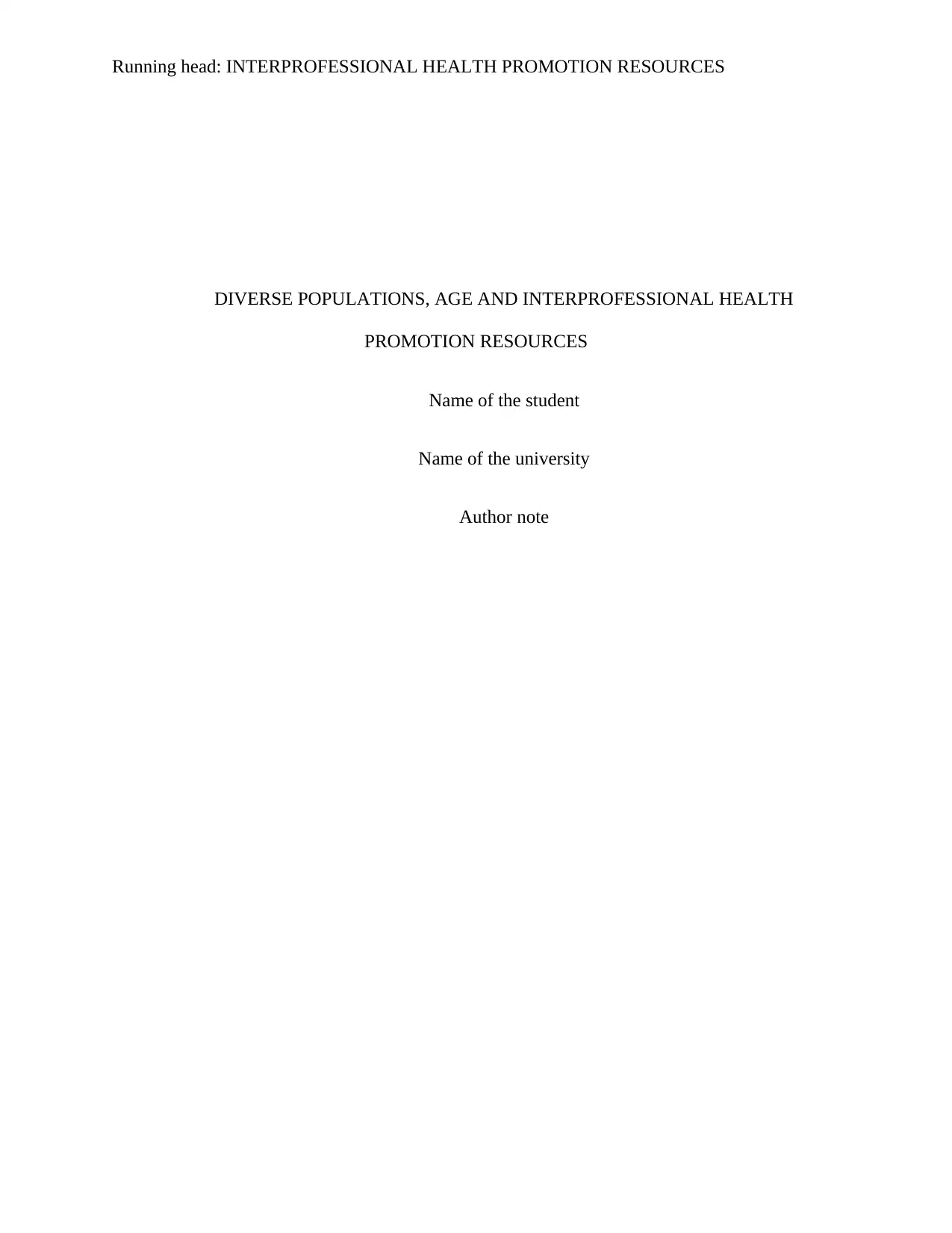
Running head: INTERPROFESSIONAL HEALTH PROMOTION RESOURCES
DIVERSE POPULATIONS, AGE AND INTERPROFESSIONAL HEALTH
PROMOTION RESOURCES
Name of the student
Name of the university
Author note
DIVERSE POPULATIONS, AGE AND INTERPROFESSIONAL HEALTH
PROMOTION RESOURCES
Name of the student
Name of the university
Author note
Secure Best Marks with AI Grader
Need help grading? Try our AI Grader for instant feedback on your assignments.
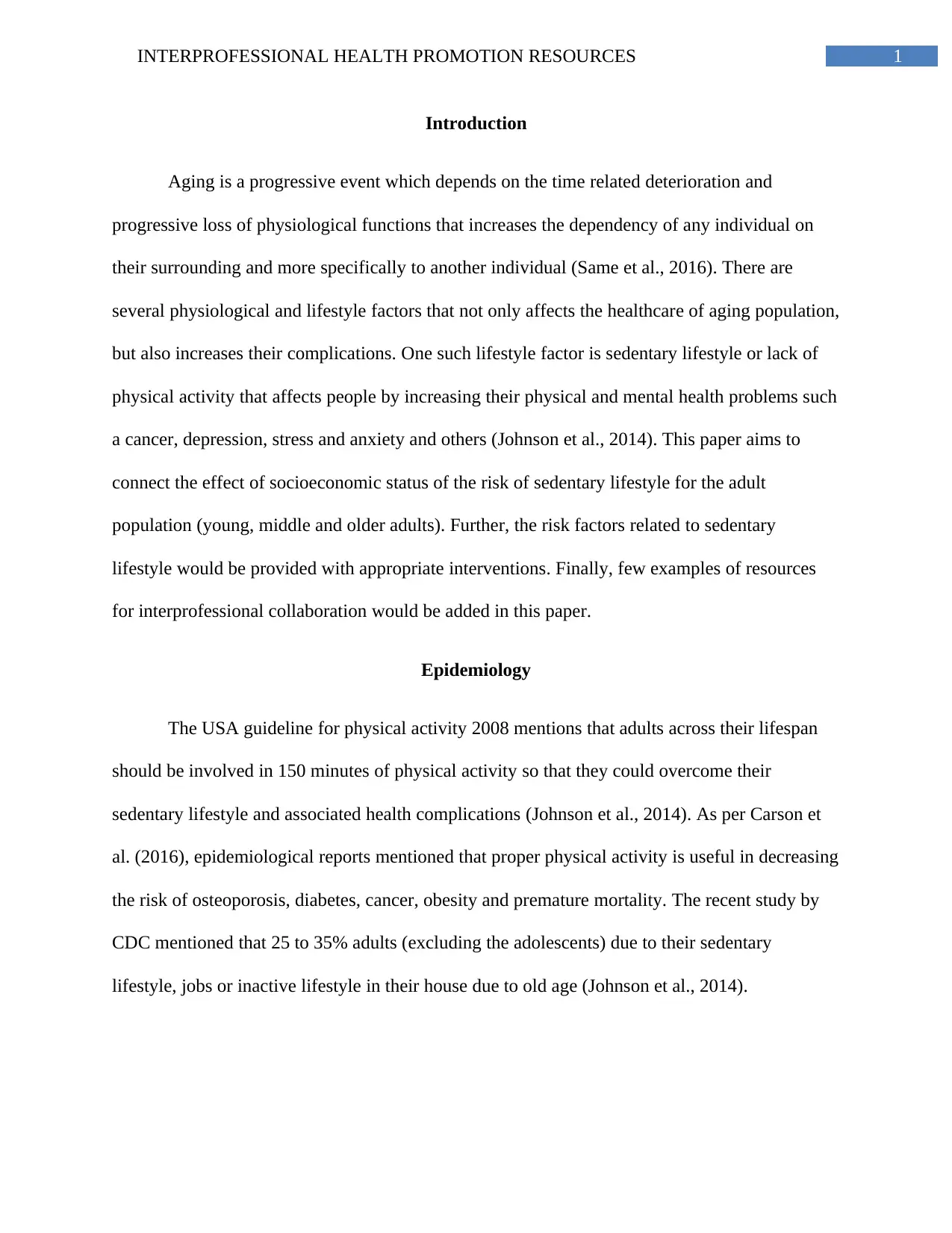
1INTERPROFESSIONAL HEALTH PROMOTION RESOURCES
Introduction
Aging is a progressive event which depends on the time related deterioration and
progressive loss of physiological functions that increases the dependency of any individual on
their surrounding and more specifically to another individual (Same et al., 2016). There are
several physiological and lifestyle factors that not only affects the healthcare of aging population,
but also increases their complications. One such lifestyle factor is sedentary lifestyle or lack of
physical activity that affects people by increasing their physical and mental health problems such
a cancer, depression, stress and anxiety and others (Johnson et al., 2014). This paper aims to
connect the effect of socioeconomic status of the risk of sedentary lifestyle for the adult
population (young, middle and older adults). Further, the risk factors related to sedentary
lifestyle would be provided with appropriate interventions. Finally, few examples of resources
for interprofessional collaboration would be added in this paper.
Epidemiology
The USA guideline for physical activity 2008 mentions that adults across their lifespan
should be involved in 150 minutes of physical activity so that they could overcome their
sedentary lifestyle and associated health complications (Johnson et al., 2014). As per Carson et
al. (2016), epidemiological reports mentioned that proper physical activity is useful in decreasing
the risk of osteoporosis, diabetes, cancer, obesity and premature mortality. The recent study by
CDC mentioned that 25 to 35% adults (excluding the adolescents) due to their sedentary
lifestyle, jobs or inactive lifestyle in their house due to old age (Johnson et al., 2014).
Introduction
Aging is a progressive event which depends on the time related deterioration and
progressive loss of physiological functions that increases the dependency of any individual on
their surrounding and more specifically to another individual (Same et al., 2016). There are
several physiological and lifestyle factors that not only affects the healthcare of aging population,
but also increases their complications. One such lifestyle factor is sedentary lifestyle or lack of
physical activity that affects people by increasing their physical and mental health problems such
a cancer, depression, stress and anxiety and others (Johnson et al., 2014). This paper aims to
connect the effect of socioeconomic status of the risk of sedentary lifestyle for the adult
population (young, middle and older adults). Further, the risk factors related to sedentary
lifestyle would be provided with appropriate interventions. Finally, few examples of resources
for interprofessional collaboration would be added in this paper.
Epidemiology
The USA guideline for physical activity 2008 mentions that adults across their lifespan
should be involved in 150 minutes of physical activity so that they could overcome their
sedentary lifestyle and associated health complications (Johnson et al., 2014). As per Carson et
al. (2016), epidemiological reports mentioned that proper physical activity is useful in decreasing
the risk of osteoporosis, diabetes, cancer, obesity and premature mortality. The recent study by
CDC mentioned that 25 to 35% adults (excluding the adolescents) due to their sedentary
lifestyle, jobs or inactive lifestyle in their house due to old age (Johnson et al., 2014).
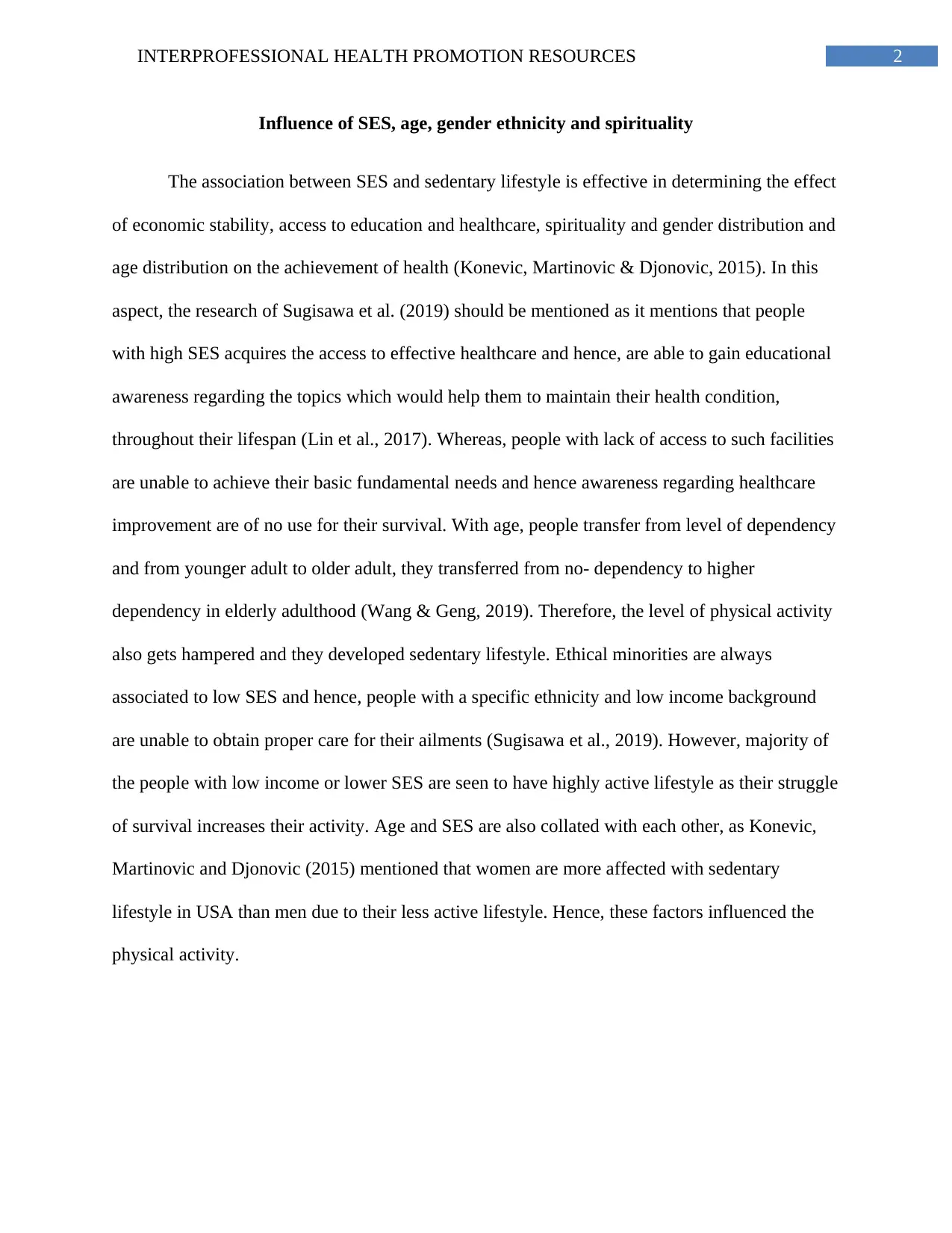
2INTERPROFESSIONAL HEALTH PROMOTION RESOURCES
Influence of SES, age, gender ethnicity and spirituality
The association between SES and sedentary lifestyle is effective in determining the effect
of economic stability, access to education and healthcare, spirituality and gender distribution and
age distribution on the achievement of health (Konevic, Martinovic & Djonovic, 2015). In this
aspect, the research of Sugisawa et al. (2019) should be mentioned as it mentions that people
with high SES acquires the access to effective healthcare and hence, are able to gain educational
awareness regarding the topics which would help them to maintain their health condition,
throughout their lifespan (Lin et al., 2017). Whereas, people with lack of access to such facilities
are unable to achieve their basic fundamental needs and hence awareness regarding healthcare
improvement are of no use for their survival. With age, people transfer from level of dependency
and from younger adult to older adult, they transferred from no- dependency to higher
dependency in elderly adulthood (Wang & Geng, 2019). Therefore, the level of physical activity
also gets hampered and they developed sedentary lifestyle. Ethical minorities are always
associated to low SES and hence, people with a specific ethnicity and low income background
are unable to obtain proper care for their ailments (Sugisawa et al., 2019). However, majority of
the people with low income or lower SES are seen to have highly active lifestyle as their struggle
of survival increases their activity. Age and SES are also collated with each other, as Konevic,
Martinovic and Djonovic (2015) mentioned that women are more affected with sedentary
lifestyle in USA than men due to their less active lifestyle. Hence, these factors influenced the
physical activity.
Influence of SES, age, gender ethnicity and spirituality
The association between SES and sedentary lifestyle is effective in determining the effect
of economic stability, access to education and healthcare, spirituality and gender distribution and
age distribution on the achievement of health (Konevic, Martinovic & Djonovic, 2015). In this
aspect, the research of Sugisawa et al. (2019) should be mentioned as it mentions that people
with high SES acquires the access to effective healthcare and hence, are able to gain educational
awareness regarding the topics which would help them to maintain their health condition,
throughout their lifespan (Lin et al., 2017). Whereas, people with lack of access to such facilities
are unable to achieve their basic fundamental needs and hence awareness regarding healthcare
improvement are of no use for their survival. With age, people transfer from level of dependency
and from younger adult to older adult, they transferred from no- dependency to higher
dependency in elderly adulthood (Wang & Geng, 2019). Therefore, the level of physical activity
also gets hampered and they developed sedentary lifestyle. Ethical minorities are always
associated to low SES and hence, people with a specific ethnicity and low income background
are unable to obtain proper care for their ailments (Sugisawa et al., 2019). However, majority of
the people with low income or lower SES are seen to have highly active lifestyle as their struggle
of survival increases their activity. Age and SES are also collated with each other, as Konevic,
Martinovic and Djonovic (2015) mentioned that women are more affected with sedentary
lifestyle in USA than men due to their less active lifestyle. Hence, these factors influenced the
physical activity.
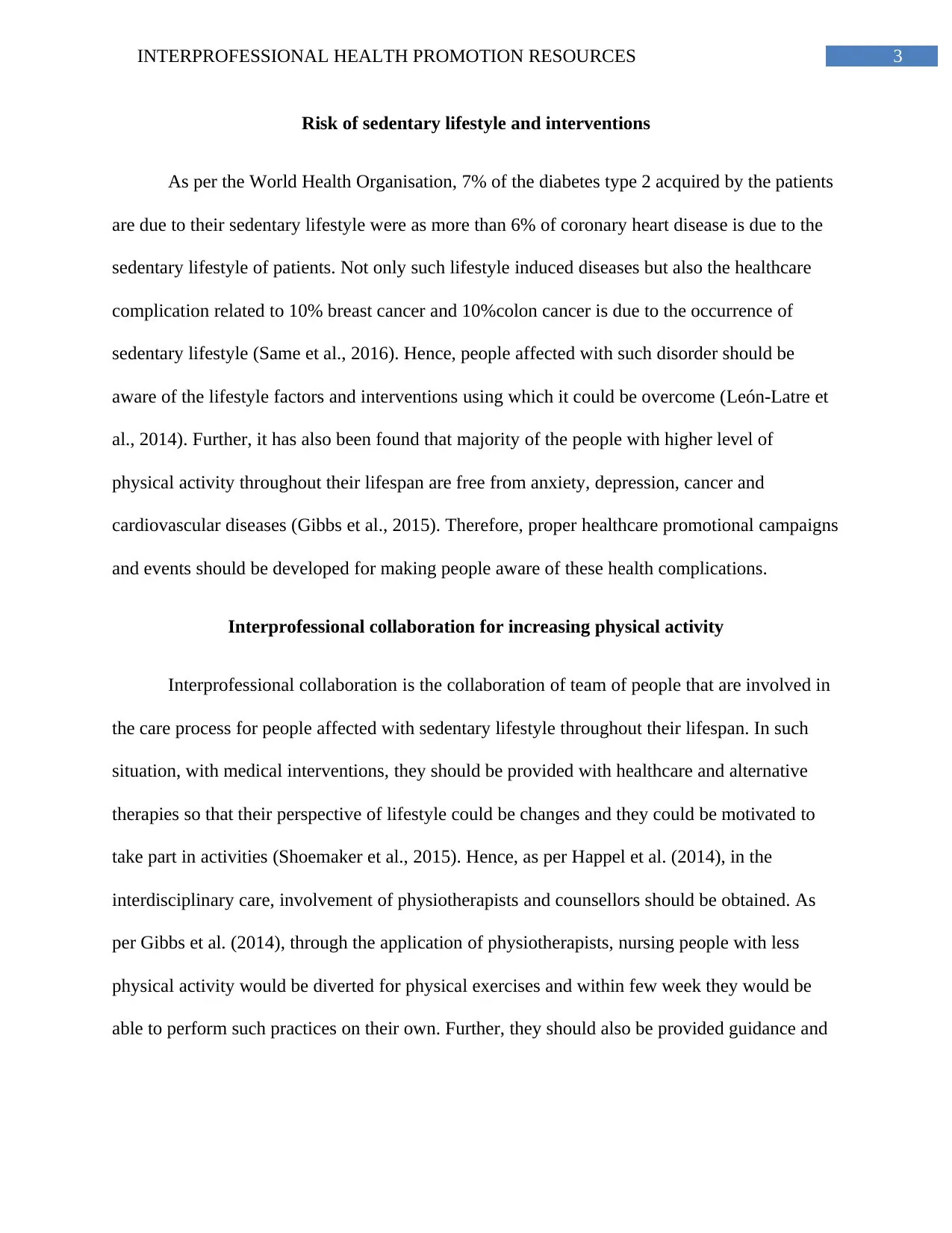
3INTERPROFESSIONAL HEALTH PROMOTION RESOURCES
Risk of sedentary lifestyle and interventions
As per the World Health Organisation, 7% of the diabetes type 2 acquired by the patients
are due to their sedentary lifestyle were as more than 6% of coronary heart disease is due to the
sedentary lifestyle of patients. Not only such lifestyle induced diseases but also the healthcare
complication related to 10% breast cancer and 10%colon cancer is due to the occurrence of
sedentary lifestyle (Same et al., 2016). Hence, people affected with such disorder should be
aware of the lifestyle factors and interventions using which it could be overcome (León-Latre et
al., 2014). Further, it has also been found that majority of the people with higher level of
physical activity throughout their lifespan are free from anxiety, depression, cancer and
cardiovascular diseases (Gibbs et al., 2015). Therefore, proper healthcare promotional campaigns
and events should be developed for making people aware of these health complications.
Interprofessional collaboration for increasing physical activity
Interprofessional collaboration is the collaboration of team of people that are involved in
the care process for people affected with sedentary lifestyle throughout their lifespan. In such
situation, with medical interventions, they should be provided with healthcare and alternative
therapies so that their perspective of lifestyle could be changes and they could be motivated to
take part in activities (Shoemaker et al., 2015). Hence, as per Happel et al. (2014), in the
interdisciplinary care, involvement of physiotherapists and counsellors should be obtained. As
per Gibbs et al. (2014), through the application of physiotherapists, nursing people with less
physical activity would be diverted for physical exercises and within few week they would be
able to perform such practices on their own. Further, they should also be provided guidance and
Risk of sedentary lifestyle and interventions
As per the World Health Organisation, 7% of the diabetes type 2 acquired by the patients
are due to their sedentary lifestyle were as more than 6% of coronary heart disease is due to the
sedentary lifestyle of patients. Not only such lifestyle induced diseases but also the healthcare
complication related to 10% breast cancer and 10%colon cancer is due to the occurrence of
sedentary lifestyle (Same et al., 2016). Hence, people affected with such disorder should be
aware of the lifestyle factors and interventions using which it could be overcome (León-Latre et
al., 2014). Further, it has also been found that majority of the people with higher level of
physical activity throughout their lifespan are free from anxiety, depression, cancer and
cardiovascular diseases (Gibbs et al., 2015). Therefore, proper healthcare promotional campaigns
and events should be developed for making people aware of these health complications.
Interprofessional collaboration for increasing physical activity
Interprofessional collaboration is the collaboration of team of people that are involved in
the care process for people affected with sedentary lifestyle throughout their lifespan. In such
situation, with medical interventions, they should be provided with healthcare and alternative
therapies so that their perspective of lifestyle could be changes and they could be motivated to
take part in activities (Shoemaker et al., 2015). Hence, as per Happel et al. (2014), in the
interdisciplinary care, involvement of physiotherapists and counsellors should be obtained. As
per Gibbs et al. (2014), through the application of physiotherapists, nursing people with less
physical activity would be diverted for physical exercises and within few week they would be
able to perform such practices on their own. Further, they should also be provided guidance and
Secure Best Marks with AI Grader
Need help grading? Try our AI Grader for instant feedback on your assignments.
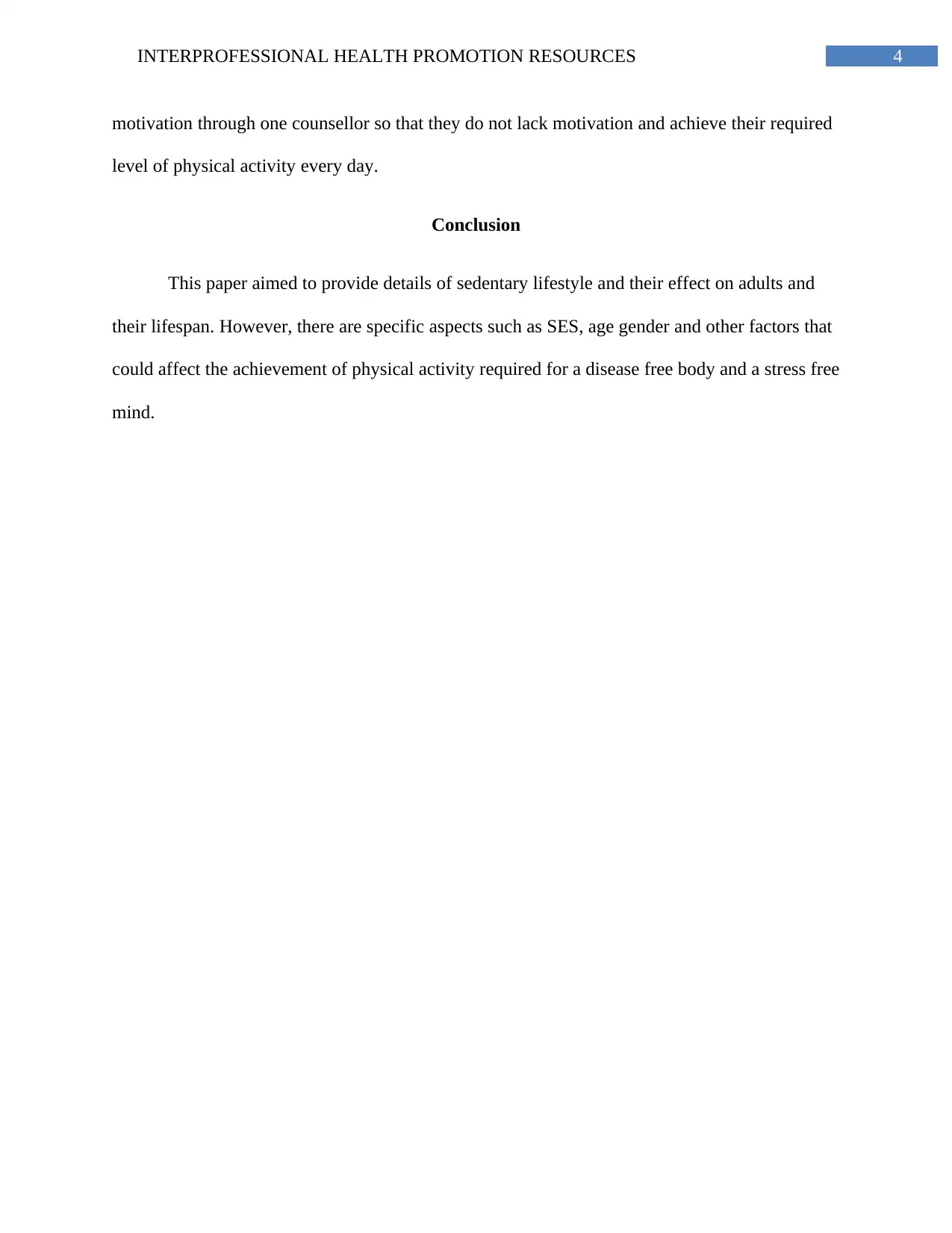
4INTERPROFESSIONAL HEALTH PROMOTION RESOURCES
motivation through one counsellor so that they do not lack motivation and achieve their required
level of physical activity every day.
Conclusion
This paper aimed to provide details of sedentary lifestyle and their effect on adults and
their lifespan. However, there are specific aspects such as SES, age gender and other factors that
could affect the achievement of physical activity required for a disease free body and a stress free
mind.
motivation through one counsellor so that they do not lack motivation and achieve their required
level of physical activity every day.
Conclusion
This paper aimed to provide details of sedentary lifestyle and their effect on adults and
their lifespan. However, there are specific aspects such as SES, age gender and other factors that
could affect the achievement of physical activity required for a disease free body and a stress free
mind.
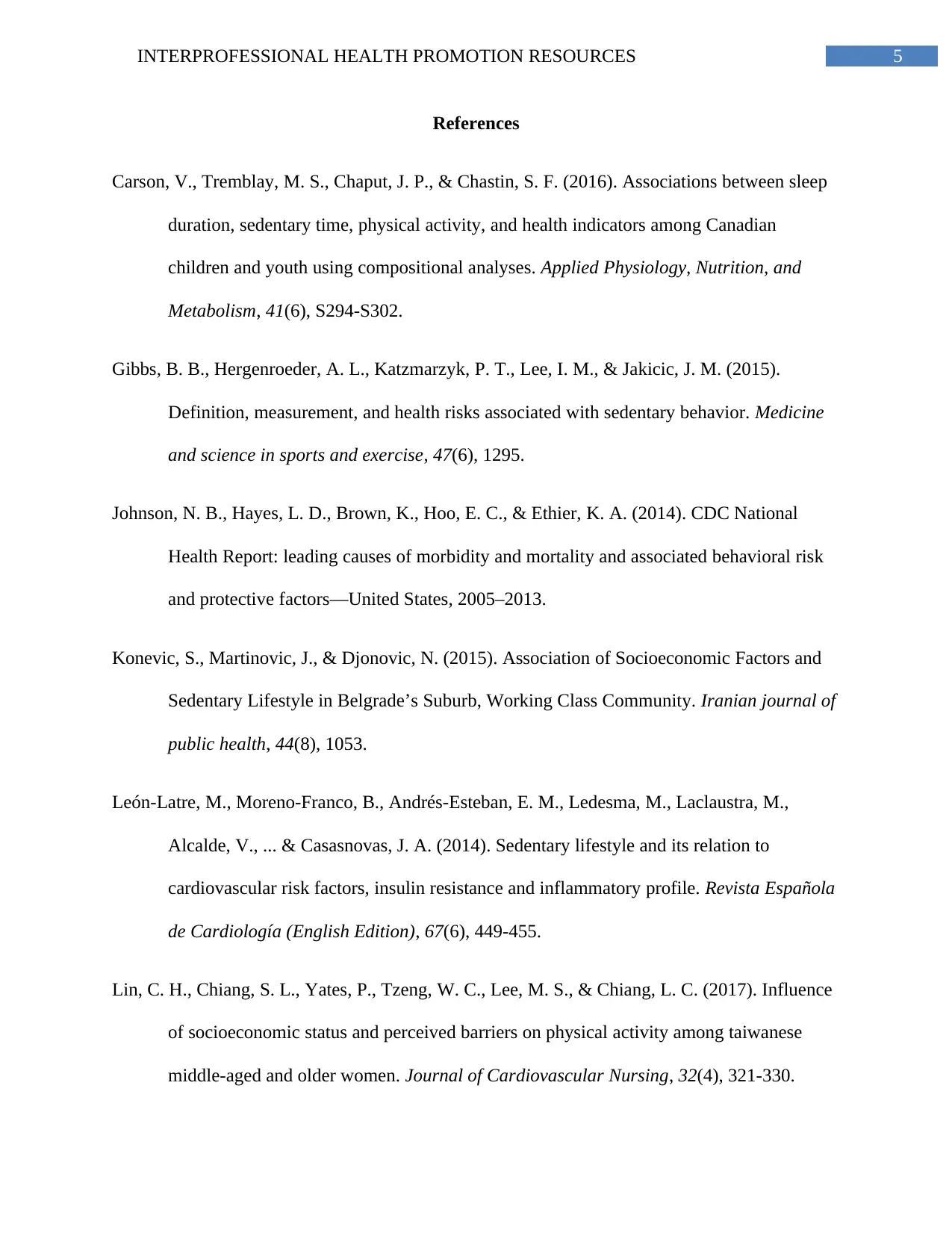
5INTERPROFESSIONAL HEALTH PROMOTION RESOURCES
References
Carson, V., Tremblay, M. S., Chaput, J. P., & Chastin, S. F. (2016). Associations between sleep
duration, sedentary time, physical activity, and health indicators among Canadian
children and youth using compositional analyses. Applied Physiology, Nutrition, and
Metabolism, 41(6), S294-S302.
Gibbs, B. B., Hergenroeder, A. L., Katzmarzyk, P. T., Lee, I. M., & Jakicic, J. M. (2015).
Definition, measurement, and health risks associated with sedentary behavior. Medicine
and science in sports and exercise, 47(6), 1295.
Johnson, N. B., Hayes, L. D., Brown, K., Hoo, E. C., & Ethier, K. A. (2014). CDC National
Health Report: leading causes of morbidity and mortality and associated behavioral risk
and protective factors—United States, 2005–2013.
Konevic, S., Martinovic, J., & Djonovic, N. (2015). Association of Socioeconomic Factors and
Sedentary Lifestyle in Belgrade’s Suburb, Working Class Community. Iranian journal of
public health, 44(8), 1053.
León-Latre, M., Moreno-Franco, B., Andrés-Esteban, E. M., Ledesma, M., Laclaustra, M.,
Alcalde, V., ... & Casasnovas, J. A. (2014). Sedentary lifestyle and its relation to
cardiovascular risk factors, insulin resistance and inflammatory profile. Revista Española
de Cardiología (English Edition), 67(6), 449-455.
Lin, C. H., Chiang, S. L., Yates, P., Tzeng, W. C., Lee, M. S., & Chiang, L. C. (2017). Influence
of socioeconomic status and perceived barriers on physical activity among taiwanese
middle-aged and older women. Journal of Cardiovascular Nursing, 32(4), 321-330.
References
Carson, V., Tremblay, M. S., Chaput, J. P., & Chastin, S. F. (2016). Associations between sleep
duration, sedentary time, physical activity, and health indicators among Canadian
children and youth using compositional analyses. Applied Physiology, Nutrition, and
Metabolism, 41(6), S294-S302.
Gibbs, B. B., Hergenroeder, A. L., Katzmarzyk, P. T., Lee, I. M., & Jakicic, J. M. (2015).
Definition, measurement, and health risks associated with sedentary behavior. Medicine
and science in sports and exercise, 47(6), 1295.
Johnson, N. B., Hayes, L. D., Brown, K., Hoo, E. C., & Ethier, K. A. (2014). CDC National
Health Report: leading causes of morbidity and mortality and associated behavioral risk
and protective factors—United States, 2005–2013.
Konevic, S., Martinovic, J., & Djonovic, N. (2015). Association of Socioeconomic Factors and
Sedentary Lifestyle in Belgrade’s Suburb, Working Class Community. Iranian journal of
public health, 44(8), 1053.
León-Latre, M., Moreno-Franco, B., Andrés-Esteban, E. M., Ledesma, M., Laclaustra, M.,
Alcalde, V., ... & Casasnovas, J. A. (2014). Sedentary lifestyle and its relation to
cardiovascular risk factors, insulin resistance and inflammatory profile. Revista Española
de Cardiología (English Edition), 67(6), 449-455.
Lin, C. H., Chiang, S. L., Yates, P., Tzeng, W. C., Lee, M. S., & Chiang, L. C. (2017). Influence
of socioeconomic status and perceived barriers on physical activity among taiwanese
middle-aged and older women. Journal of Cardiovascular Nursing, 32(4), 321-330.
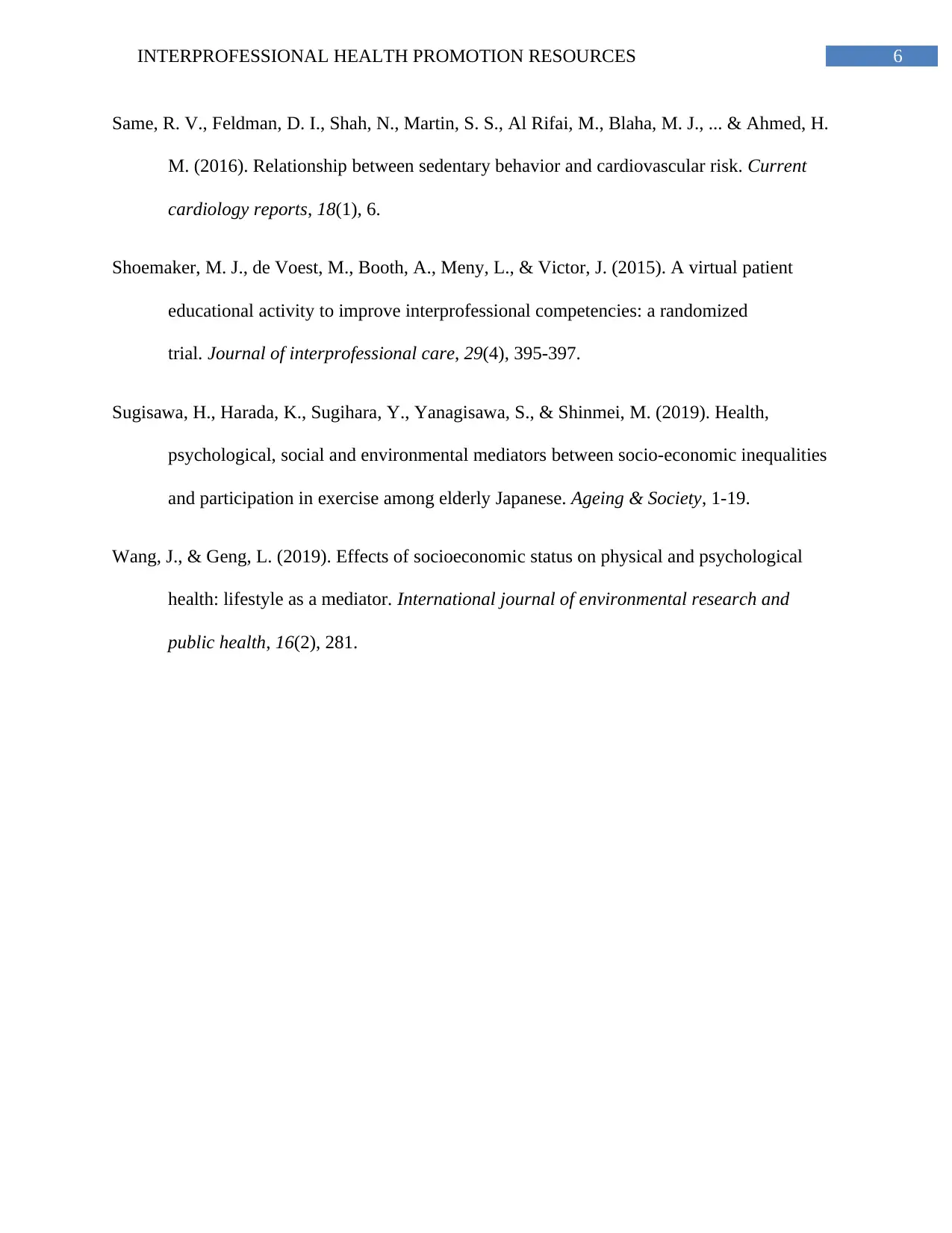
6INTERPROFESSIONAL HEALTH PROMOTION RESOURCES
Same, R. V., Feldman, D. I., Shah, N., Martin, S. S., Al Rifai, M., Blaha, M. J., ... & Ahmed, H.
M. (2016). Relationship between sedentary behavior and cardiovascular risk. Current
cardiology reports, 18(1), 6.
Shoemaker, M. J., de Voest, M., Booth, A., Meny, L., & Victor, J. (2015). A virtual patient
educational activity to improve interprofessional competencies: a randomized
trial. Journal of interprofessional care, 29(4), 395-397.
Sugisawa, H., Harada, K., Sugihara, Y., Yanagisawa, S., & Shinmei, M. (2019). Health,
psychological, social and environmental mediators between socio-economic inequalities
and participation in exercise among elderly Japanese. Ageing & Society, 1-19.
Wang, J., & Geng, L. (2019). Effects of socioeconomic status on physical and psychological
health: lifestyle as a mediator. International journal of environmental research and
public health, 16(2), 281.
Same, R. V., Feldman, D. I., Shah, N., Martin, S. S., Al Rifai, M., Blaha, M. J., ... & Ahmed, H.
M. (2016). Relationship between sedentary behavior and cardiovascular risk. Current
cardiology reports, 18(1), 6.
Shoemaker, M. J., de Voest, M., Booth, A., Meny, L., & Victor, J. (2015). A virtual patient
educational activity to improve interprofessional competencies: a randomized
trial. Journal of interprofessional care, 29(4), 395-397.
Sugisawa, H., Harada, K., Sugihara, Y., Yanagisawa, S., & Shinmei, M. (2019). Health,
psychological, social and environmental mediators between socio-economic inequalities
and participation in exercise among elderly Japanese. Ageing & Society, 1-19.
Wang, J., & Geng, L. (2019). Effects of socioeconomic status on physical and psychological
health: lifestyle as a mediator. International journal of environmental research and
public health, 16(2), 281.
1 out of 7
Related Documents
Your All-in-One AI-Powered Toolkit for Academic Success.
+13062052269
info@desklib.com
Available 24*7 on WhatsApp / Email
![[object Object]](/_next/static/media/star-bottom.7253800d.svg)
Unlock your academic potential
© 2024 | Zucol Services PVT LTD | All rights reserved.





